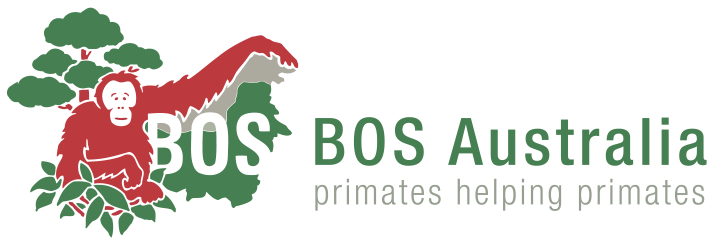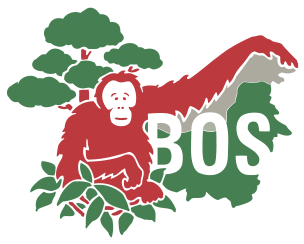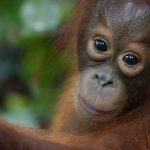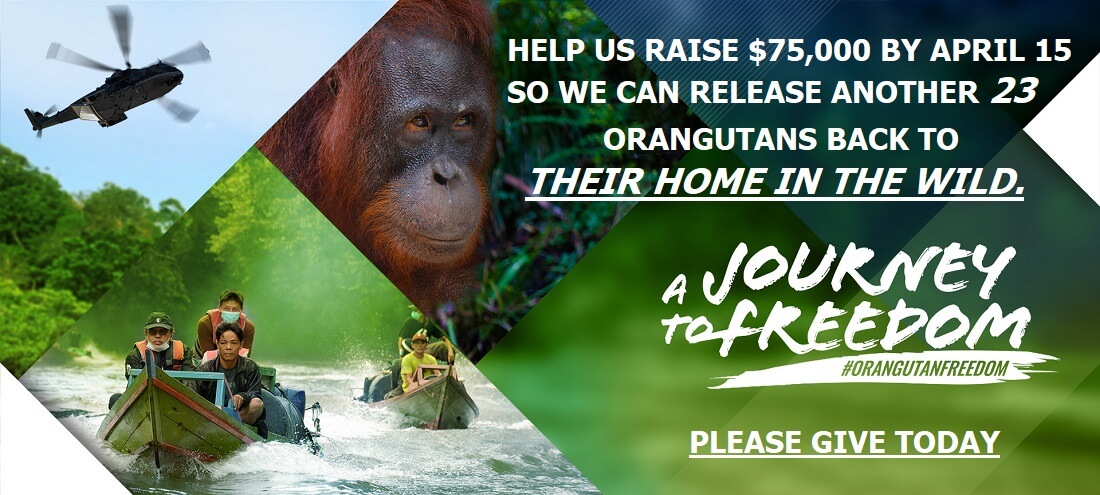Borneo’s moment of truth
Borneo’s Moment of Truth
National Geographic; Mel White, November 2008. Photograph: Mattias Klum
The majestic forests are vanishing in smoke and sawdust, but there’s still hope for the island’s fabled biodiversity—if the palm oil rush can be slowed.
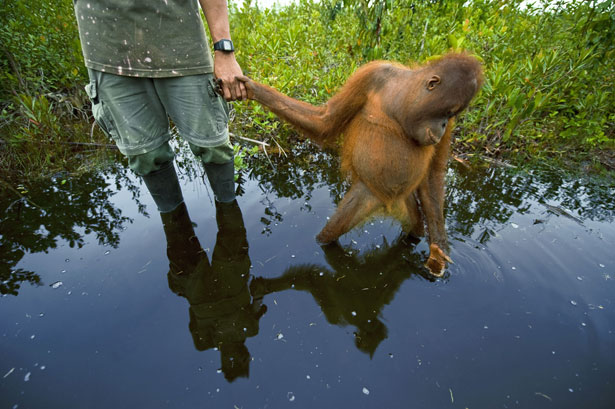
First, I will tell you about the Borneo of your dreams.
The day starts well before dawn with the lunatic hooting of gibbons, the rain forest’s alarm clock, lovers and rivals wooing and warning each other from the treetops in an urgent ape language that I, their terrestrial relative, can only guess at.
From my camp a creekside trail leads into forest past trees whose massive trunks rise a hundred feet to the lowest branches. As sunlight makes its feeble way through the dense green canopy, another primate, a long-tailed macaque, walks along the stream below, hoping for a breakfast of fish or frog. Whether it’s successful or not, its expression of perpetual irritation will never change. No sooner has the monkey disappeared upstream than a pair of short-tailed mongooses bound down to the bank, seemingly more intent on fun than food.
At a clearing, a pair of rhinoceros hornbills fly to a fruiting tree on loud-whooshing wings and begin to feed. Mostly black, nearly the size of turkeys, they have huge red-and-yellow casques on their bills that gleam in the sun like polished lacquer. The birds outshine everything else in the forest until a hand-size shape flits erratically past at waist level, deep velvety black, but also crimson and electric green, screaming neon green, a color as gaudy as the name of this creature: Rajah Brooke’s birdwing. At almost seven inches across, it’s one of the largest butterflies in the world. If the rhinoceros hornbill doesn’t take your breath away—if the Rajah Brooke’s birdwing doesn’t—have someone hold your wrist and check for a pulse.
Later I take a small boat down a broad river called the Kinabatangan, then up a side channel as narrow as an alleyway. A troop of proboscis monkeys climb through the branches overhead, where they will spend the night in tall trees beside the water. The potbellied male, ridiculously outsize nose hanging from his face like a ripe fruit, is so ugly he’s endearing, in a kind of bibulous-old-uncle way. Most of the pointy-nosed females under his watch cradle young at their breasts. Silvered leaf monkeys look down from above, and a bearded pig stands just inside the forest to watch us pass. As the boat drifts below an overhanging branch, a four-foot-long water monitor lizard drops into the water.
A Borneo pygmy elephant enters the river and swims in front of the boat, blowing like a whale. “Pygmy” it may be in comparison to other elephants, but when it emerges dark and shining on the opposite bank, it’s as if an island is rising from the sea. I see where it’s going: A herd of around 30 animals—a long-tusked bull, many adult females, and various young—munch tangled vines beside the main river, expressionless as statues and only marginally more animated.
This is the mythic Borneo, the island of the world’s imagination, and it’s all as wondrous as it sounds. But if you want to see the real Borneo, the Borneo of the first decade of the 21st century, it would be good to be the crested serpent-eagle perched in a tree across the river. Then you could soar high above the Kinabatangan and see how quickly the unruly forest gives way to neatly planted rows of oil palm trees, stretching for mile after mile in all directions. The palm plantation is lush and green, and the arching fronds of the trees give it an exotic beauty, and for the incomparable biodiversity of Borneo it is inexorable death.
Set between the South China and Java Seas, bisected by the Equator, the island of Borneo has served throughout human history mostly to have its natural resources exploited—many would say plundered—by a succession of peoples from around the world.
Chinese traders came for rhinoceros horn, the aromatic wood called gaharu, and birds’ nests for soup. Later, Muslim and Portuguese traders joined them to export pepper and gold. Britain and the Netherlands controlled the island during the colonial period of the 19th and early 20th centuries, when loggers began cutting the tropical hardwood forest covering the island. The current political division of Borneo—the southern three-quarters belongs to Indonesia, most of the rest to Malaysia, with slivers that make up Brunei—reflects alliances of the British and Dutch colonial era, which ended with independence after World War II.
In recent decades, companies from Europe, the United States, and Australia have drilled for abundant oil and natural gas and strip-mined coal. There are mansions from Amsterdam to Melbourne, from Singapore to Houston, that were built with wealth from Borneo. Mansions built with Borneo wealth stand in Jakarta and Kuala Lumpur, too, because Indonesia and Malaysia, or at least the political and economic elite, have been the biggest plunderers of all.
A different kind of richness has attracted others, including the great naturalist Alfred Russel Wallace, who spent time here in the mid-1850s while he developed theories important to modern understanding of evolution and biogeography. Wallace collected more than a thousand species new to science, including Rajah Brooke’s birdwing. Scientists have continued making discoveries ever since, demonstrating that the rain forest of Borneo ranks with the most biologically diverse places on Earth.
Borneo has more than 15,000 known species of plants, including more than 2,500 species of orchids. Southeast Asia’s lowland forests, including Borneo’s, are the tallest tropical rain forests in the world, and may have as many as 240 species of trees on a single four-acre site. Borneo is home to the world’s largest flower, the world’s largest orchid, the world’s largest carnivorous plants, and the world’s largest moth. In the multilevel structure of Borneo’s rain forest lives the world’s largest collection of gliding animals: Apart from several species of flying squirrels there are flying lizards, flying colugos, flying frogs, and—the stuff of nightmares for some—flying snakes.
Sun bears and clouded leopards roam Borneo’s forests, while two species of gibbons and eight species of monkeys climb in the trees. Around a thousand elephants have survived in one corner of the island—mostly in the Malaysian state of Sabah, where the Kinabatangan River runs to the Sulu Sea. Rhinoceroses barely hang on to existence, with fewer than four dozen remaining. But it’s an even more charismatic animal—the orangutan—that has become the symbol of Borneo. Its expressive eyes stare out from the newsletters and funding appeals of conservation groups around the world. Considering the island’s unsurpassed biodiversity—from orangutans and rhinoceroses to tiny mosses and beetles not yet discovered—and the rate at which its forests are being lost, Borneo’s future may well be the most critical conservation issue on our planet.
From a satellite perspective, the threat of Borneo’s imminent deforestation might seem overstated. The island, slightly larger than Texas, is still half covered with trees, and in the interior highlands stand hundreds of square miles of virgin forests where almost no one goes save indigenous hunters, wildlife poachers, and gaharu gatherers. Reaching some areas requires a boat trip of several days or strenuous hikes through pathless wilderness.
But it’s an entirely different story, and an increasingly desperate one, for lowland forests, the prime habitat for most of Borneo’s wealth of biodiversity, including orangutans and elephants. During the past two decades, an estimated two million acres were cleared annually, an area more than half the size of Connecticut. A paper in Science magazine in 2001—ominously titled “The End for Indonesia’s Lowland Forests?”—warned of the “dire consequences” of “the current state of resource anarchy” and cited a study predicting that lowland forests in Indonesian Borneo could be totally destroyed by 2010. While government crackdowns have slowed illegal logging and exports, the result has simply been to delay the forecast doomsday.
Other factors could speed it up again. In the past 20 years vast, single-crop plantations of oil palm have spread across Borneo to meet the demand for the versatile (and vastly profitable) oil derived from its fruit. Palm oil is used for cooking, and in cosmetics, soap, desserts, and a seemingly endless list of other products, including biofuel. Indonesia and Malaysia provide 86 percent of the world’s supply; growing conditions are perfect on Borneo for this green gold. Even as conservationists spread the news about palm oil’s contribution to global deforestation—some calling for boycotting of palm oil products—Indonesia has become the world’s number one producing country, with 15 million acres under cultivation, a figure that may double by 2020.
As if the oil palm monoculture weren’t enough, Borneo possesses another resource that combines economic blessing and environmental danger: The 300-million-year-old plant material that once grew on what is now Borneo lies underground, transformed into coal. Surface mines—for gold as well as coal—spread across southern and eastern Borneo like pockmarks, displacing forest and polluting rivers with waste.
And in a world newly awakened to the dangers of climate change, Borneo has gained global attention for yet another reason: A specialized ecosystem called peat swamp forest covers around 11 percent of the island. Here, trees grow on highly organic soil built of centuries’ accumulation of waterlogged plant material. Sometimes reaching a depth of 60 feet, peat soil represents a massive store of the world’s carbon. Stripped of its trees and drained, tropical peat decays and releases its carbon into the atmosphere, and as it dries it becomes extremely susceptible to burning, intentional or accidental. Massive annual fires set deliberately to clear previously forested land for new oil palm plantations—and exacerbated by frequent drought—have burned out of control and filled Borneo’s skies with smoke, closing airports and causing respiratory problems for millions of people as far away as mainland Asia. Carbon released by decaying peat soil, fires, and deforestation has pushed Indonesia into third place among nations as a source of greenhouse gases, behind only heavily industrialized China and the United States.
Time is running out for Borneo’s rain forests. Conventional models offer little hope. Setting aside large areas as parks or reserves, standard practice in the U.S. and other countries, has been largely ineffective, at least on the Indonesian part of Borneo, undermined by inadequate funding, lack of support from local residents, and government corruption. But many conservationists say that logging, often regarded as anathema to wildlife, may, if practiced sustainably, in fact help to protect a significant portion of the island’s biodiversity.
“Virgin rain forest is a dead concept now in Borneo,” says Glen Reynolds, chief scientist at the Danum Valley Field Center in Sabah. “All of the big areas of primary lowland forest that can be conserved already have been. It’s difficult, but now what you’ve got to do is convince people that what we think of as degraded forest can sustain biodiversity.”
The message is complex but ultimately clear. To protect Borneo’s forests and wildlife will require rethinking old ideas, accepting new truths, and adopting new models of conservation. And in the end, the fate of Borneo may be decided far from the forests, in government offices and corporate boardrooms from New York to Geneva. Because of the vast amounts of carbon tied up in the plants and soils, the last best hope for Borneo’s future may rest not on the emotional appeal of an orangutan’s face, but on the hard facts of climate change—and our own determination and ability to protect ourselves from disaster.
On the opposite side of Borneo from Sabah, in the Indonesian province of West Kalimantan, a narrow paved road leads away from Pontianak, a city near the South China Sea. Crowded with trucks and buzzing motorbikes, the road passes wooden shops and houses in small villages separated by rice fields. The harvest has just begun, and here and there people beat sheaves against wooden lattices or toss grains into the air to let the wind carry away the hulls. There’s little trace of the forests that once stood here.
I’m traveling with Dessy Ratnasari, a scientist from a local research organization, whose animated face is encircled by a light blue head scarf. Our driver, Harun—who, like many Indonesians, uses only one name—speaks up as we pass a large building fringed with weeds.
“This is a sawmill where he worked,” Ratnasari translates. “It went bankrupt because there are no more trees for timber. It had 1,300 workers and a payroll of 800 million rupiah a month”—about $90,000. Within a couple of miles we pass two more mills, gates locked, windows broken, parking lots empty.
“There were several big companies and some smaller mills around Pontianak,” Harun says. “Now there’s only one big company still operating.”
How did nearly a third of the rain forest that stood on Borneo in 1985 disappear by 2005? An easy, and only slightly oversimplified, answer can be found in the initials that Indonesians use as an explanation for many of their country’s troubles: KKN, for korupsi, kolusi, nepotisme (corruption, collusion, nepotism). During the 32-year presidency of Suharto, until he was forced from office in 1998, Indonesian forests were among the many resources treated as personal wealth by him, his family, and military officials who helped keep him in office. Since Suharto, political power has been decentralized, and decision-making about natural resources has become more localized. Unfortunately, too often the result has been what one conservationist calls “the democratization of corruption.”
Local officials, having watched Suharto et al. loot the country for decades, began cashing in themselves. Many provincial governors, district bupati (regents), and police avidly took bribes: from timber companies, to grant logging permits in nominally protected forests; from illegal loggers, to ignore intrusions into national parks; and from oil palm companies, to allow wholesale clearing and burning of forestlands for plantations. Chaotically confused jurisdiction and land-ownership issues made matters worse. Although the national government claims to administer forestry laws, provinces and districts often issue land-use permits independently, and conflicting court decisions contributed to the free-for-all atmosphere.
Across the border in Malaysian Borneo, the state of Sarawak has been controlled for 27 years by Chief Minister Abdul Taib Mahmud, whose administration is widely regarded as dictatorial and corrupt. Uncontrolled logging has so greatly depleted Sarawak’s forests that most conservationists working to save Borneo’s biodiversity have, in a kind of environmental triage, essentially given up and focused their attentions elsewhere on the island. Having ravaged its forests, Sarawak has now turned its attention to its large areas of coastal peat swamp forest, rapidly converting tracts to oil palm despite environmentalists’ concerns over carbon emissions.
The natural world fares better in Sabah, the Malaysian state in northeastern Borneo. Though oil palm plantations have burgeoned here, more than half of Sabah remains forested. Much of the forest has been heavily logged, and more and more acres converted to commercial tree plantations, but Sabah sustains some of the best surviving examples of high-quality rain forest: the Danum Valley and Maliau Basin Conservation Areas. (The nation of Brunei has so much money from petroleum that there’s been no need to exploit its forests. It retains some of the best rain forest on Borneo, but, since it occupies less than one percent of the island, it makes a negligible contribution to the overall conservation picture.)
“Good governance” is a bureaucratic phrase often used by diplomats and nongovernmental organizations working in Indonesia and Malaysia. What it means in plain terms is removing the hands of politicians and their cronies from the pockets of poor people and opening up government actions to public scrutiny and free debate. Everyone working on conservation in Borneo agrees that no efforts—no laws or regulations, no new parks or protected areas—will be effective without it.
“Governance is almost everything, in that if we can’t get it right, nothing else matters,” says Frances Seymour of the Center for International Forestry Research (CIFOR), an international organization headquartered in Indonesia and committed to conserving forests and improving the livelihoods of people in the tropics. There have been encouraging signs of progress in Indonesia—at least at the higher levels of government—especially since 2004, when Susilo Bambang Yudhoyono was elected president. Another major step began in 2000 when the national police force loosened ties with the military, a notoriously corrupt organization with long-standing links to illegal logging and smuggling. Even better news came in 2005, when General Sutanto was appointed national chief of police. “No law enforcement head anywhere in the world has made as much progress as he has,” a senior U.S. official in Jakarta told me.
Hundreds of arrests for illegal logging activities have been made since then, targeting not just workers in the field (who may make as little as two dollars a day), but also, occasionally, mid-level timber buyers and government officials, including the ex-governor of the Indonesian province of East Kalimantan and many workers in the corruption-tainted Ministry of Forestry. Gunung Palung National Park in West Kalimantan, once a horror story of uncontrolled illegal logging and poaching, has seen a major turnaround thanks to an honest and dedicated director whose rangers patrol the park with ultralight aircraft and motorboats.
On a national level, many Indonesian ministers get high marks, or at least grudgingly awarded passing grades, for their dedication to reform. “And yet I will say that in this village there is no question that it’s impossible to get a policeman to do anything without being asked for a bribe,” a person connected to a small conservation group tells me. (As happened often when I talked with activists, I was asked not to name the speaker.) “The bupati has friends in Jakarta who could shut us down,” another NGO worker says. “It’s a fine line you have to walk here. They could crush us if they wanted to.”
In several district capital towns I visited, the most obvious result of increased local autonomy was a showy new government office complex; the second-most-obvious was the bupati’s showy new house. “The challenge,” Frances Seymour says, “is how we help communities and local governments make better decisions for the long term, because what’s going on now is a short-term spasm of making money, and ten years from now jobs are going to be gone and income sources are going to be gone.” And the Indonesian hinterlands will remain as poor as ever.
A highway winds through jagged limestone hills in East Kalimantan, following a route that five years ago was a dirt logging road. Today there’s nothing but scrub in all directions. Every mile or so, as the highway crosses a ravine, there’s a minor cave-in that’s caused the lane on the downhill side to collapse. We rarely have to slow down, though, because there’s almost no other traffic. Sometimes these bus-size chasms are marked with branches piled in the road, and sometimes they’re not.
“The contractor gives a kickback to the government to get the paving contract, and then they purposely do a bad job so they can come back in a few years for repair work and everybody can make more money,” one of my companions says. By now I’ve heard stories like this so often that they seem normal.
After crossing a bridge over the Telen River, we stop near a roadside house that barely qualifies for the name. It’s an open-air wooden platform no more than ten feet square, elevated on logs head-high off the ground. The roof is a sheet of blue plastic suspended from poles. A woman and two children are on the platform and three more children are playing underneath.
Felled tree trunks are scattered across a field beyond the house; the ground is blackened from recent burning, and smoke rises here and there. Several men and women work in the field with machetes and long digging sticks made of belian, or ironwood. This is forest destruction and habitat loss happening before my eyes.
Two men come over to talk with us—Udan Usat and Ismael, uncle and nephew. They wear Javanese-style conical straw hats against the intense sun. Their faces and arms are coated with soot, and sweat makes small rivulets on their skin.
They are of the Kenyah tribe, and they moved here last year. Before, they lived in a village called Long Noran on the Wahau River, in the interior of Borneo. The forest there is long gone, cut by a big timber company once owned by the notorious Bob Hasan, a Suharto crony and former government minister who was later convicted of corruption. With only scrub left, the entire area around their village, which stood inside the company’s timber concession, burned in massive fires in 1997-98. The blazes were ignited by companies preparing land for plantations and spread rapidly to neighboring land during a season of drought.
“We had gardens, fruit trees, rubber trees, and vegetable fields, all burned,” Udan Usat says. “There was conflict with the timber company. They accused us of starting the fires, but we didn’t do it. The fires came from far away.”
Things were very hard after that. “Where we lived it was an hour by boat and 15 kilometers by land to reach the nearest settlement with a market,” he says. “It was expensive to use the boat.”
The government promised that each family could have five hectares, about 12 acres, along the road here, if they wanted to move. Some of the villagers came to look at the land, there was a meeting, and 169 families decided to start over again at this place.
“Here, we are between two towns, so it will be easier to sell our crops when the fields begin producing,” Ismael says. Neighboring families are helping each other, working on a different plot each day. They will grow rice, bananas, and the spiny red fruit called rambutan. The burning they’ve just done will help the fertility of the soil, and they hope to have their first crops next year. Families are living in temporary shelters for now, because it’s more important to plant the fields than build permanent houses. Ismael was head of an elementary school in Long Noran, and someday, if there are enough children here on the Telen River, the families may build a school.
“Life will be better here—that is our hope,” Ismael says.
I thank these men for talking with me, and wonder whether I should give them money for their time. My binoculars cost more than the two of them will make in an entire year. I turn to go, and one of the children, a girl about seven years old, is holding a plastic bag with two ontok, fried dough balls; and lemper, rice wrapped in coconut leaf—a gift of food for me. She hands me the bag, and her smile shatters my heart.
Despite the stupendous new skyscrapers erupting around Jakarta, despite the new cars clogging its streets, the essential fact influencing conservation in Borneo is the extreme poverty of most Indonesians, who occupy three-quarters of the island. Whatever strategies environmentalists pursue to save Borneo’s biodiversity must first offer ways for its residents to improve their lives.
“Nothing is more important than hunger,” says Albertus of the Pontianak-based group Green Borneo. “Funding agencies need to change their way of thinking about this. Better health, better education, better economic conditions—that will help protect the forest.”
Even as she shows me West Kalimantan ecosystems and economies wrecked by unsustainable logging, Dessy Ratnasari makes sure I know the benefits it brought. “Many people in West Kalimantan grew up on money from timber companies,” she says. “I grew up on the multiplier effects, because my father had a small clothing store, and the money people spent there came from timber. That is why I was able to go to school and get an education.”
Hati-hati is one of the few phrases of Indonesian I’ve learned. It means “be careful,” as on the signs along this bumpy dirt road reading “Hati-Hati Logging.” It’s a hot morning in East Kalimantan, and I’m riding in a truck with Erik Meijaard, a Dutch conservation scientist associated with the Nature Conservancy who has worked in Borneo for 15 years, and his colleague Nardiyono. We’ve passed through miles of scrubland, and the landscape shows no sign of changing anytime soon. Once lowland rain forest, this area was clear-cut and never reforested. In the fires of 1997-98, it was part of the estimated 6.5 million acres of forest that burned in East Kalimantan. Now it is only bushes, small trees, ferns, and grass, overrun with vines. I stare at the passing scene, thinking that, if nothing else, the government responsible for allowing this is guilty of criminal negligence.
“It’s sad, isn’t it?” Meijaard says, reading my thoughts. “And yet,” he continues, “this is the kind of forest where Nardi and I find some of our highest concentrations of orangutans.” By “find” he means they have counted the nests that orangutans make each night or discovered other signs indicating the animals’ presence. Orangutans are the most solitary of the great apes, difficult to spot even where they exist in good numbers. Meijaard has already told me that he has actually seen only two wild orangutans in the past two and a half years of regular fieldwork.
The truck crests a low rise in the road and—I almost feel I should interject here I am not making this up—there’s a dark reddish-brown form in the road ahead. I see it, but my mind seems to stall. Midday … worthless scrubland … animal in the road … What? Gibbon?
“Orangutan!” Erik and Nardi shout in unison. The truck skids to a stop, and we all jump out as the orangutan retreats into the low woods beside the road. I follow it with my binoculars as it scuttles away, stopping repeatedly to look back at us, until it moves downslope out of sight.
The normally taciturn Nardi is beside himself. “You are so lucky!” he says, over and over. “An orangutan, right in the road!” Expletives and superlatives abound. Visitors to Borneo rarely see a wild orangutan; most see the semi-tame animals at well-known rehabilitation centers such as Sepilok in Sabah or Tanjung Puting National Park in Central Kalimantan.
There’s more to this incident, though, than simply my winning-the-Powerball good fortune. What I’ve just seen symbolizes one of the most important issues for Borneo’s biodiversity—and a tenuous hope for preserving it.
“The logged forest is the future for wildlife in Borneo,” says Siew Te Wong, who works on conservation of the threatened sun bear.
“In Borneo, species do not go extinct over a broad area as a result of one round of logging, or even two and possibly three,” says Junaidi Payne of WWF’s Sabah office. “The balance of species changes enormously, but even the specialist birds or orchids or epiphytes are still there if you look in little valleys and the wet areas. So you can log forests and still save that biodiversity. But the thing you can’t do is convert the whole thing to monoculture plantations,” such as oil palm. “Then of course you lose everything. It’s a biological desert.”
WWF geographer Raymond Alfred shows me around Sabah’s state-owned Ulu Segama Forest Reserve, where the forest has been thoroughly—and legally—logged, leaving woodland that seems downright puny compared with the skyscraping rain forest at nearby Danum Valley. Yet researchers have found Borneo’s highest concentration of orangutans here, and the species is thriving in similar spots all around the island. Alfred and other Sabah conservationists managed to convince the government to save this degraded forest, once set for conversion to oil palm. A ten-year moratorium on logging has given them time to study the orangutans, and they hope to establish a lodge and attract some of the tourists who visit the nearby Kinabatangan River Sepilok rehabilitation center.
In East Kalimantan, Meijaard has spent much of his time in recent years working with logging companies to help them harvest trees sustainably, and with local villages to find ways for them to derive income from the forest. Purists may imagine the major conservation goal in Borneo to be the setting aside of vast tracts of untouched forest, but for biologists dealing with day-to-day reality, compromise is the only realistic alternative.
When Meijaard spends time in villages discussing the choice between forest conservation and oil palm plantations, he never mentions orangutans. “People get bored with that in five minutes. To them it’s just another monkey in a tree that Western people want to come and look at. But if I talk to them about fish in the rivers or pigs in the forest, then they pay attention, because those are resources they can harvest from the forest.”
Meijaard is unsentimental about timber harvesting and the sanctity of virgin rain forest. “Hey, it’s the tropics. Plants will grow back,” he says. “These forests have to earn their money somehow.” Otherwise, they’ll inevitably be turned into plantations of oil palm or pulpwood.
“You’re trying to get people who have economic opportunities right now to forgo those benefits for other benefits years down the road,” orangutan conservationist Paul Hartman says. “The bupati is in office for five years, and he says, ‘I’m going to make my money now.’
“Sustainable forest management—logging that provides income without compromising the long-term viability of the ecosystem, won’t be an easy sell. In Sangatta, East Kalimantan, I talk with Daddy Ruhiyat, an adviser to the local government on conservation issues. “We have asked forestry companies to show us that forests can be as financially productive as oil palm,” he says. “But nowadays there are no fresh ideas coming from the forestry sector to make land more productive. We have a choice of either good forest and no money, or cut down the forest for palm oil. There is a long list of companies asking for land for palm oil development.”
Ruhiyat sees a role for forestry in his district, but primarily in plantations of fast-growing teak, which can be harvested every 15 years. “We want species that can be productive in a relatively short rotation,” he says. “We have to grow forests in plantations. That is the only way.”
I ask him how he feels about someone like me, from a country that cut its forests, mined its coal, depleted its wildlife, and became wealthy, coming to Borneo to question local people’s decisions about conservation.
“It is reasonable that people in other countries are concerned about the Borneo environment,” he says. “I’m not resentful of that. But the most important step is to make people have better incomes. It starts with oil palm plantations, which bring money so people can enjoy better lives. It is hard for hungry people to appreciate nature.”
Glen Reynolds of the Danum Valley Field Center says that “payment for environmental services” is the only thing that will tip the balance away from clear-cutting and palm plantations. He uses the broad term for finding ways to pay communities, regions, or countries to keep their ecosystems healthy and functioning. “Without that there’s going to be no lowland forest left on Borneo in ten years,” Reynolds says.
The 1997 Kyoto Protocol on reducing greenhouse gases to combat climate change controversially made no provision to pay for protection of existing forests—”avoided deforestation”— but the December 2007 multinational conference in Bal
